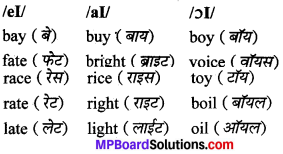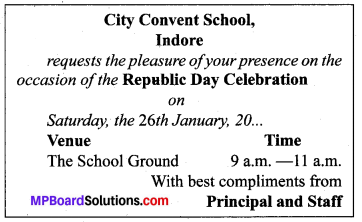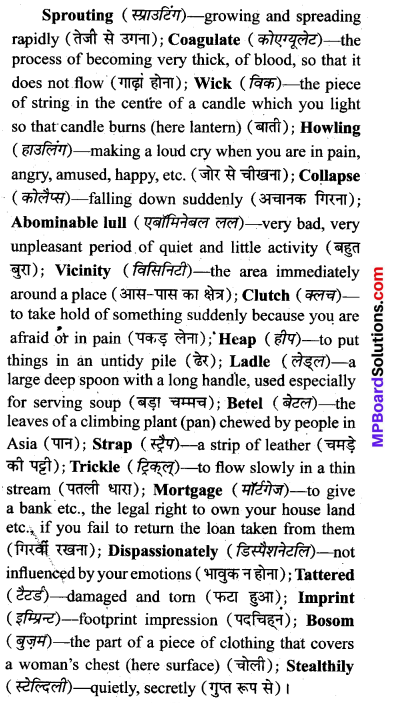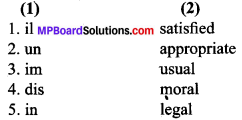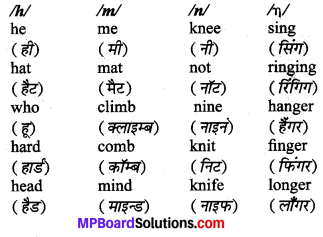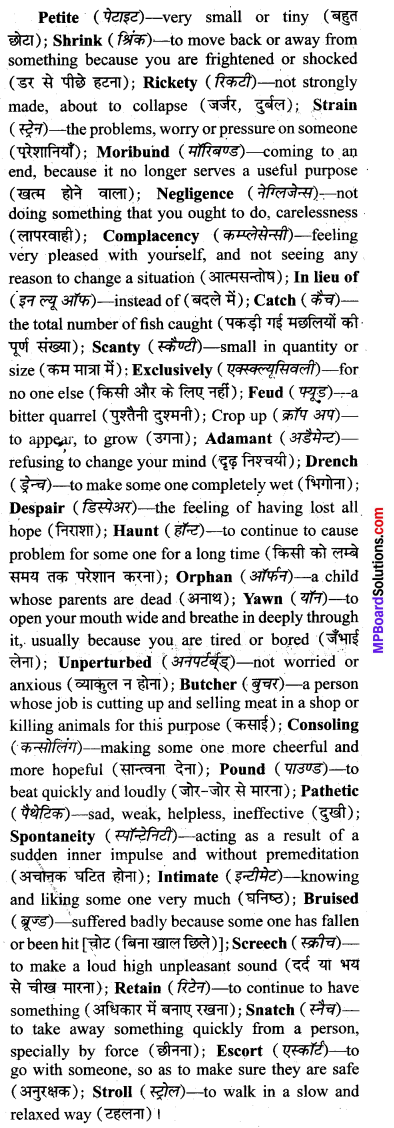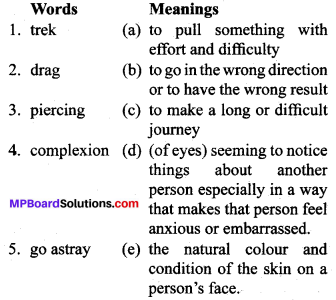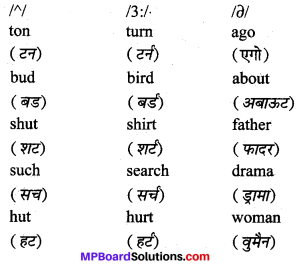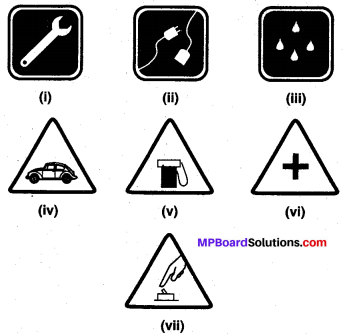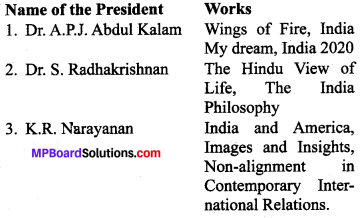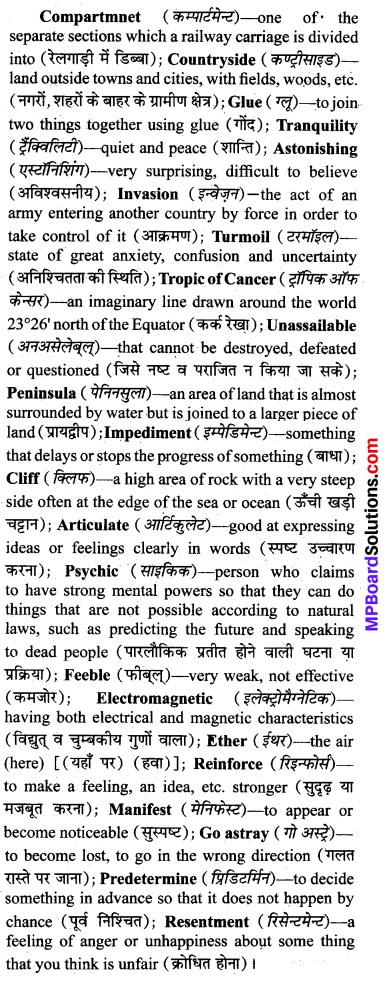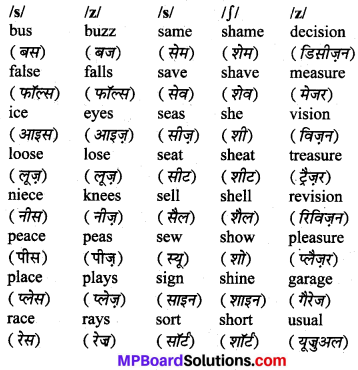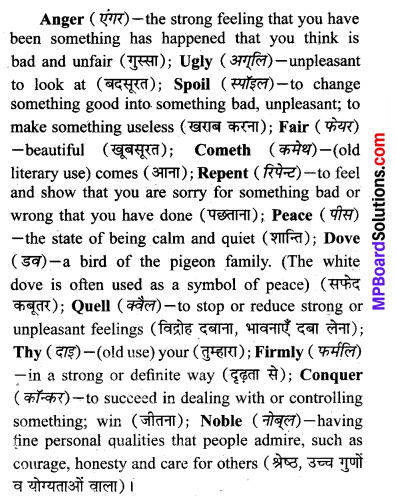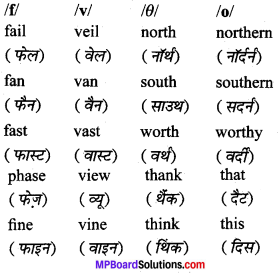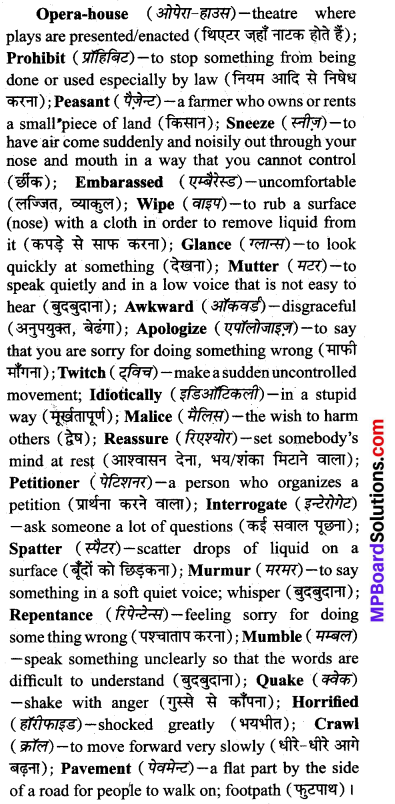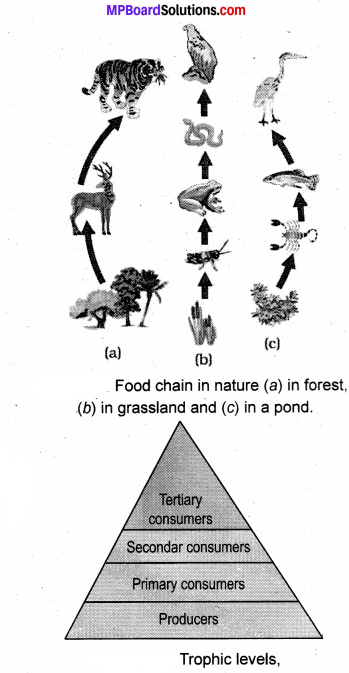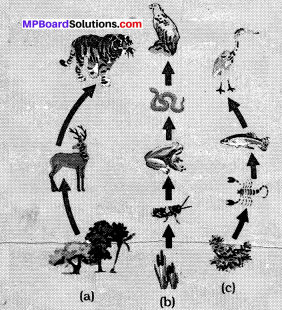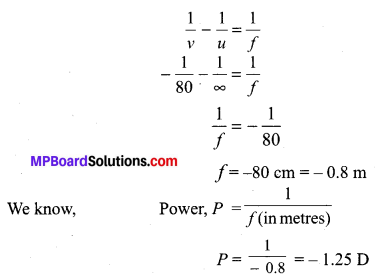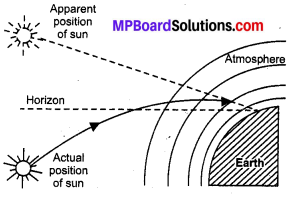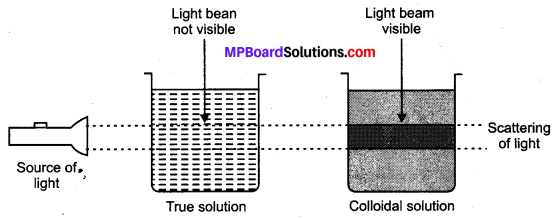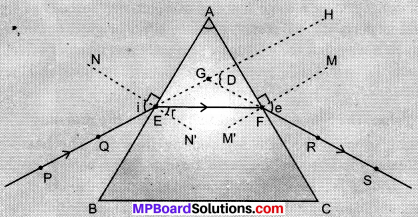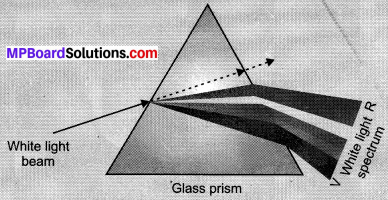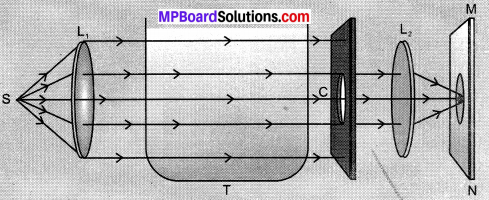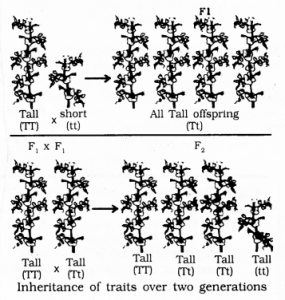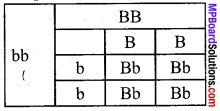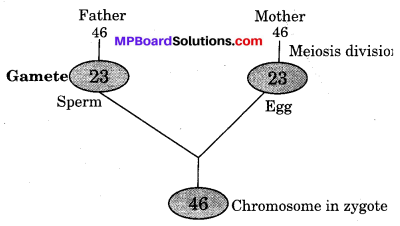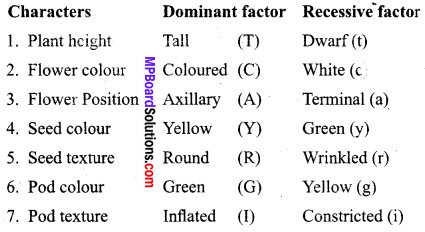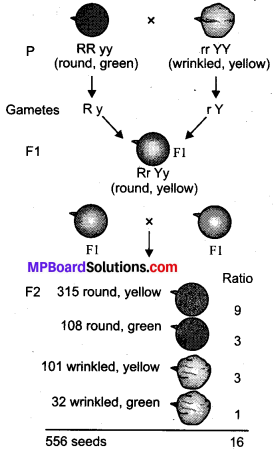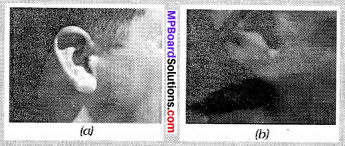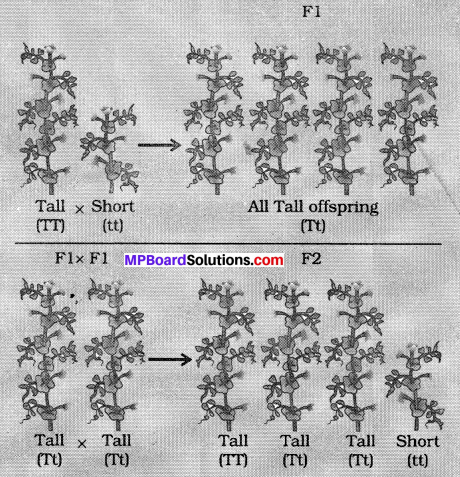Are you seeking for the Madhya Pradesh Board Solutions 10th General English The Spring Blossom Solutions Chapter 11 Wind Questions and Answers PDF? If yes, then read this entire page. Here, we are giving a direct link to download MP Board Class 10th English Solutions Questions and Answers PDF which contains the chapter wise questions, solutions, and grammar topics. You can also get the shortcuts to solve the grammar related questions on this page.
MP Board Class 10th General English The Spring Blossom Solutions Chapter 11 Wind
For the sake of students we have gathered the complete 10th General English The Spring Blossom Solutions Chapter 11 Wind Questions and Answers can provided in pdf Pattern. Refer the chapter wise MP Board Class 10th English Solutions Questions and Answers Topics and start the preparation. You can estimate the importance of each chapter, find important English grammar concepts which are having more weightage. Concentrate on the important grammar topics from Madhya Pradesh Board Solutions for 10th English Chapter 11 Wind Questions and Answers PDF, prepare well for the exam.
Wind Textual Exercises
Word Power
A. Match the following words with the rhyming ones.
(सुमेलित कीजिए।)
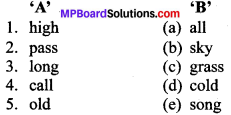
Answer:
1. → (b)
2. → (c)
3. → (e)
4. → (a)
5. → (d)
B. Give one word for the following expressions.
(एक शब्द दीजिए)
Answer:
- air that moves quickly as a result of natural forces – wind
- to put something in a secret or unknown place – hide
- large and dangerous animal – beast
- a device or a person that produces a current of air – blower
C. Study the meanings of the words starting with ‘wind’ in the book and fill in the blanks making necessary changes.
(रिक्त स्थान भरिए।)
Answer:
- Calm down! Can’t you see he is only winding up.
- Can I wind my window down?
- If we all agree, let’s wind up the discussion.
- Many governments are winding down their nuclear programmes.
How Much Have I Understood?
A. Answer these questions. (One or two sentences)
(निम्न प्रश्नों के उत्तर एक या दो वाक्यों में दीजिए।)
Question 1.
Who takes the kites high?
(हू टेक्स द काइट्स हाइ?)
पतंगों को ऊँचा कौन ले जाता है?
Answer:
The wind takes the kites high.
(द विण्ड टेक्स द काइट्स हाइ।)
हवा पतंगों को ऊँचा ले जाती है।
Question 2.
What does the wind always do?
(व्हॉट डज़ द विण्ड ऑल्वेज़ डू?)
हवा हमेशा क्या करती है?
Answer:
Wind always hides itself after doing different things.
(विण्ड ऑल्वेज़ हाइड्स इटसेल्फ आफ्टर डूइंग डिफ्रेंट थिंग्स।)
हवा हमेशा विभिन्न कार्य करने के पश्चात् खुद छुप जाती
Question 3.
How does the wind work?
(‘हाउ डज़ द विण्ड वर्क?)
हवा कैसे कार्य करती है?
Answer:
A wind works by blowing. It sometimes pushes and sometimes makes a loud sound.
(अ विण्ड वर्क्स बाइ ब्लोइंग। इट समटाइम्स पुशेज़ एण्ड समटाइम्स मेक्स् अ लाऊड साऊण्ड।)
हवा बहकर कार्य करती है। यह कभी धक्का देती है व कभी तेज आवाज करती है।
Question 4.
What does the poet want to know about the wind?
(व्हॉट डज़ द पोऍट वॉण्ट टू नो अबाऊट द विण्ड?)
कवि हवा के विषय में क्या जानना चाहता है?
Answer:
The poet wants to know that whether the wind is young or old.
(द पोऍट वॉण्ट्स् टू नो दैट वैदर द विण्ड इज़ यंग और ओल्ड।)
कवि यह जानना चाहता है कि हवा उम्र में छोटी है या बड़ी।
Question 5.
What does the poet ask in the last stanza?
(व्हॉट डज़ द पोऍट आस्क् इन द लास्ट स्टैजा?)
कवि आखिरी पद में क्या पूछता है?
Answer:
The poet asks in the last stanza that whether the wind is a beast or just a stronger child than the poet himself.
(द पोऍट आस्क्स इन द लास्ट स्टैंजा दैट वैदर द विण्ड इज़ अ बीस्ट और जस्ट अ स्ट्राँगर चाइल्ड दैन द पोऍट हिमसेल्फ।)
कवि आखिरी पद में पूछता है कि क्या हवा एक पशु है या फिर सिर्फ कवि से ज़्यादा बलशाली बालक है।
B. Answer these questions. (Three or four sentences)
(निम्न प्रश्नों के उत्तर तीन या चार वाक्यों में दीजिए।)
Question 1.
What are the types of works of the wind as described in the poem?
(व्हॉट आर द टाइप्स ऑफ वर्क्स ऑफ द विण्ड एज़ डिस्क्राइब्ड इन द पोऍम?)
कविता में हवा के किस प्रकार के कार्य वर्णित हैं?
Answer:
In the poem it has been described that a wind tosses the kites high and blows the birds in the sky. It also pushes different objects.
(इन द पोऍम इट हैज़ बीन डिस्क्राइब्ड् दैट अ विण्ड टॉसेज़ द काइट्स् हाय एण्ड ब्लोज़ द बर्ड्स इन द स्काय। इट ऑल्सो पुशेज़ डिफ्रेन्ट ऑब्जेक्ट्स्।)
कविता में हवा के कार्यों का वर्णन करते हुए कहा गया है कि हवा पतंगों को आकाश में उड़ा देती है व चिड़ियाँ आकाश में बहने लगती हैं। वह विभिन्न वस्तुओं को धकेलती भी है।
Question 2.
What does the poet want to know about the ‘blower’ the wind?
(व्हॉट डज़ द पोऍट वॉण्ट टू नो अबाऊट द ‘ब्लोअर’-द विण्ड?)
कवि ‘फॅकनी’ हवा के विषय में क्या जानना चाहता है?
Answer:
The poet wants to know whether the ‘blower’, the wind is young or old.
(द पोऍट वॉण्ट्स टू नो वैदर द ‘ब्लोअर’, द विण्ड इज़ यंग और ओल्ड।)
कवि यह जानना चाहता है कि हवा उम्र में कम है या अधिक है।
Listening Time
From the given story complete these statement.
(निम्न वाक्यों को पूरा कीजिए।)
Answer:
- One day, Hodja came to talk to the people.
- The first time, the people answered that they did not know what Hodja was going to say.
- The second time they said they knew what Hodja was going to say.
- The third time they thought they would be cleverer than Hodja.
- But Hodja showed them that he was the cleverer of them all.
Speaking Time
Talk to your friends by using the given question.
(दी गई प्रश्नों द्वारा अपने मित्रों से बात करिए।)
Answer:
Students can talk to their friends by asking the questions given in the book.
(छात्र आपस में स्वयं बात करें।)
Writing Time
A. Study the graph given in the textbook and answers the following questions.
(पुस्तक में दिये गये ग्राफ को देखकर निम्न प्रश्नों के उत्तर दीजिए।)
Question 1.
What was the difference between the highest, maximum temperature and the lowest minimum temperature?
Answer:
50°F (95°F-45°F).
Question 2.
Name those months when the minimum temperature was below 60°F.
Answer:
January, February, October, November, December
Question 3.
Which month had the minimum difference between the two kinds of temperature?
Answer:
July.
Question 4.
Which was the coldest month?
Answer:
January
Question 5.
What are the lowest and highest limits of the minimum temperature?
Answer:
Lowest limit – 75°F, Highest limit – 45°F.
B. Write a letter to the Collector requesting him to ban the use of loud speakers.
(कलेक्टर को लाउडस्पीकर पर रोक लगाने के लिए पत्र लिखो।)
Answer:
31, Ashish Nagar,
Katni
1st April, 20 ….
To,
The district Magistrate,
Katni
Subject: Ban on the use of loud-speakers
Sir,
I want to draw your attention to the nuisance caused by the use of loud-speakers. I am a student of high school and my examinations are near. It is a time when all the students are busy day and night preparing for the examinations. Their success depends upon the proper use of their time and the concentration of their minds. It is regrettable that majority of the citizens do not realise the importance of this time for ! students. They enjoy full liberty to use loud-speakers at their highest pitch to celebrate every occasion that comes to their hands. The result is that we are unable to make preparations in the right way. I therefore request you to kindly impose a ban on the use of loud-speakers for the period of Board Examinations and punish those who are found guilty.
Thanking you.
Yours faithfully
Raj Malhotra
Things to do
Read the column ‘Letters to Editor’ in an English newspaper, cut at least five letters and paste them in your file. Read one of them in your class.
(किसी अंग्रेजी अखबार में ‘सम्पादक को पत्र’ शीर्षक पढ़िए। कम-से-कम पाँच पत्र अपनी पुस्तिका में काटकर चिपकाइए। उनमें से एक कक्षा में पढ़िए।)
Answer:
Students can cut the columns from any English newspaper such as Times of India, Hindu, Hindustan Times and paste them in their notebooks themselves.
(छात्र स्वयं करें।)
Wind Central Idea of the Poem
The poem is about wind. The wind while blowing throughout the day and being invisible does several tasks. It raises the kites to great heights, causes the flight of birds in the sky, pushes things and sometimes causes disasters. It sometimes blows fast making loud sound and at other time it is cool and pleasant.
Wind Difficult Word Meanings
Wind (विण्ड)-air that moves quickly as a result of natural forces (आँधी); Toss (टाँस)-to make something move from side to side or up and down (उछालना); Ladies skirt (लेडीज़ स्कर्ट) lahanga (लहँगा); Hide (हाइड)-to put something in a place where it cannot be seen (छुपाना); Blower (ब्लोअर)-a device or a person that produces a current of air (फूँकनी); Beast (बीस्ट)-an animal, especially one that is large or dangerous (पशु)
Wind Summary, Pronunciation & Translation
saw you toss the kites on high
And blow the birds about the sky;
And all around I heard you pass,
Like ladies’ skirts across the grass…….
O wind, a-blowing all day long,
O wind, that sings so loud a song!
(आई सॉ यू टॉस द काईट्स ऑन हाई
ऐण्ड ब्लो द बर्ड्स अबाऊट द स्काई;
ऐण्ड ऑल अराऊण्ड आई हर्ड यू पास,
लाईक लेडीज़ स्कर्ट्स अक्रॉस द ग्रास……..
ओ विण्ड, अ-ब्लोईंग ऑल डे लॉन्ग,
ओ विण्ड, दैट सिंग्स सो लाऊड अ सॉन्ग!)
अनुवाद :
मैंने तुम्हें पतंगों को ऊँचाई की तरफ उछालते देखा है
और पक्षियों को आकाश में उड़ाते हुए;
और सब तरफ मैंने तुम्हें गुज़रते सुना है,
(तुम्हारे गुज़रने से उत्पन्न होने वाली ध्वनि ऐसी है)
जैसे महिलाओं के चलते समय उनके घाघरों के पास से टकराने से उत्पन्न ध्वनि ……….
ओ पूरे दिन बहते रहने वाली हवा,
ओ ऊँचे स्वर में गीत गाती हवा!
I saw the different things you did,
But always you yourself you hid.
I felt you push, I heard you call,
I could not see yourself at all ……..
O wind, a-blowing all day long,
O wind, that sings so loud a song!
(आई सॉ द डिफरेण्ट थिंग्स यू डिड
बट आलवेज् यू यॉरसेल्फ यू हिड।
आई फेल्ट यू पुश, आई हर्ड यू कॉल,
आई कुड नॉट सी यॉरसेल्फ ऐट ऑल ………
ओ विण्ड, अ-ब्लोईंग ऑल डे लॉन्ग,
ओ विण्ड, दैट सिंग्स सो लाऊड अ सॉन्ग!)
अनुवाद :
तुमने जो अलग-अलग कार्य किए मैंने वह देखे,
परन्तु हमेशा तुमने स्वयं को छिपा लिया।
मैंने तुम्हें धकेलते हुए महसूस किया,
मैंने तुम्हें पुकारते हुए सुना,
पर मैं तुम्हें बिल्कुल भी देख नहीं पाया……….
ओ पूरे दिन बहते रहने वाली हवा,
ओ ऊँचे स्वर में गीत गाती हवा!
O you that are so strong and cold,
O blower, are you young or old?
Are you a beast of field and tree,
Or just a stronger child than me?
O wind, a-blowing all day long,
O wind, that sings so loud a song!
(ओ यू दैट आर सो स्ट्रॉन्ग ऐण्ड कोल्ड,
ओ ब्लोअर, आर यू यंग ऑर ओल्ड?
आर यू अ बीस्ट ऑफ फील्ड ऐण्ड ट्री,
ऑर जस्ट अ स्ट्रॉन्गर चाईल्ड दैन मी?
ओ विण्ड, अ-ब्लोईंग ऑल डे लॉन्ग,
ओ विण्ड, दैट सिंग्स सो लाऊड अ सॉन्ग!)
अनुवाद :
ओ तुम जो इतने ठण्डे और बलशाली हो,
ओ बहाने वाले तुम जवान हो या वृद्ध?
क्या तुम पेड़ों-मैदानों के कोई जन्तु हो।
या फिर सिर्फ मुझसे बलशाली एक बच्चे?
ओ पूरे दिन बहते रहने वाली हवा,
ओ ऊँचे स्वर में गीत गाती हवा!
Hope that the above shaped information regarding the Madhya Pradesh Board Solutions for 10th English Chapter 11 Wind Questions and Answers is useful for making your preparation effective. View our website regularly to get other subjects solutions.
